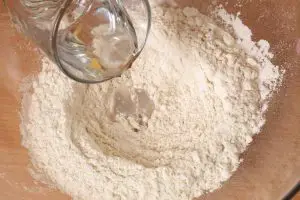While many, many people enjoy kneading and making bread themselves, there is no question that making your own bread can be time-consuming and frustrating. As such, more and more people are choosing to use bread machines. Bread machines take much of the physical work out of making bread, combining the kneading process, the mixing process, and allowing time for bread to rise. With a good bread machine, all you need to do is add the ingredients in at the right times and before you know it, you will have a fresh loaf of bread to enjoy, right?
This is the case as long as you add the right ingredients to the bread. Unfortunately, bread can be finicky, and if you don’t add the correct proportions of ingredients to the machine, you will end up with a loaf of bread that simply isn’t right. Depending on what ingredient or which setting on the bread machine was the issue, your loaf of bread can turn into something that only vaguely resembles dough.
One common problem that people will have with bread from their bread machines is that they will see the bread collapse. This problem can be hard to source, as it happens somewhat later in the bread-making process, so you may not find out quick enough. Only when you open the bread machine will you find the collapsed bread. If this problem has happened to you, you might be wondering what causes it and what you can do to fix it.
First things first, you need to have a good understanding of the role yeast plays in breadmaking.
Last update on 2025-06-29 / Affiliate links / Images from Amazon Product Advertising API
Yeast and Rising Bread
There are two major components of bread that are attributed to its ability to rise. These components are yeast, a fungus that produces carbon dioxide that allows for the bread to rise and have air pockets, and gluten, a protein found in wheat that becomes more flexible when water is added to it. These two components combined allow for the dough itself to stretch as the gluten absorbs the carbon dioxide, leaving you with a wonderfully fluffy loaf of bread.
So, what does this have to do with collapsing bread? When there is a problem with one of these components, your bread will not rise properly. Without gluten, the dough cannot expand as it should, leading to flatter, denser loaves of bread. Without enough yeast, the bread cannot expand fast enough, taking far longer to develop, and if the gluten content is correct, this can cause the loaf to rise at first, but collapse on itself as the lessened yeast stops producing carbon dioxide for the gluten to make use of.
This means that the answer to why does bread machine bread collapse is that there is often a problem with the yeast, especially concerning too little yeast or other problems that cause the yeast to die off.
What Leads to Too Little Yeast?
There are a few different things that can kill or inhibit the yeast in bread-machine bread. The biggest problems that you will encounter are going to be the amount of liquid in the dough and the temperature. If there is too much liquid in the dough, the yeast will be inhibited or in a worst case situation, it will be killed. Without that yeast, the bread will collapse on itself after the gluten helps it rise. Likewise, if the temperature is too high, the yeast will die as well, leaving you with the same problem.
Another situation that this can happen in is if you simply didn’t add the right amount of yeast. Naturally, if there is not enough yeast for a recipe, then the bread is not going to develop properly. Yeast is a fungus, meaning that it is technically alive. This makes checking the expiration date on any yeast you have important, as adding dead yeast to bread will have the same effect as adding too little yeast. Finally, if you are used to working with the much stronger instant yeasts, you may not realize that dry yeasts take more to have the same effect.
When all is said and done, the most common reasons why your bread is collapsing in the bread machine is due to a measuring error either concerning the yeast or the water content of the bread. If it isn’t a measuring problem, then there’s likely a chance that the issue is going to be with the yeast itself rather than anything else. Make sure that you always double-check your measurements and properly store the yeast you have so that you can keep making the optimal bread loaves. It will also help to know what dough with too much liquid looks like so that you can recognize the problem and take care of it before you put it in the bread machine. Dough that has too much liquid tends to be stickier than optimal dough.









